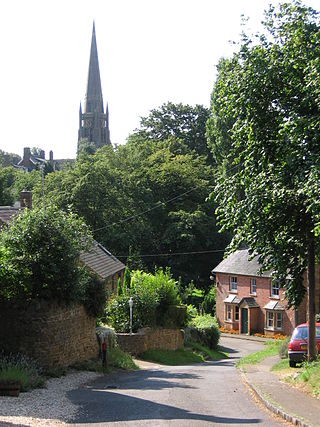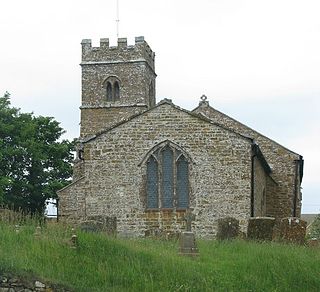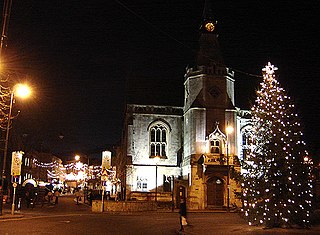 | |
| Industry | Alcoholic beverage |
|---|---|
| Founded | 1840 |
| Founder | John Hunt |
| Successor | Bass, Mitchells & Butlers |
| Headquarters | , |
| Products | Beer |
Hunt Edmunds was a brewery in Banbury, Oxfordshire, England.
 | |
| Industry | Alcoholic beverage |
|---|---|
| Founded | 1840 |
| Founder | John Hunt |
| Successor | Bass, Mitchells & Butlers |
| Headquarters | , |
| Products | Beer |
Hunt Edmunds was a brewery in Banbury, Oxfordshire, England.
The brewery was founded by John Hunt in 1840, [1] but it was Thomas Hunt who went into partnership with William Edmunds (1826–1908) in 1850. [2] Edmunds' son, Charles Fletcher Edmunds (1855–1907) became a partner in 1886, and succeeded his father in 1896. His son Maurice Edmunds (d. 1950) was a later chairman. Eventually the brewery had over 100 pubs. [3] Other breweries in the town were taken over along with their pubs, including the former Austin's Brewery in North Bar, latterly owned by Messrs Dunnell; William Barrett's Britannia Brewery in Newland Road; and the Banbury Brewery Co. in Bridge Street. [4]

By 1886 the company had two breweries and 64 tied houses in Banbury. The main brewery was on the southern side of Bridge Street, Banbury, and extended all the way back to George Street. [5] Brews included "Banbury Best Bitter", "Banbury Brown Ale" and "Banbury Cross Ale". [1] Other breweries were taken over, including the Banbury Brewery Company (acquired in 1879), Barrett's of Banbury (acquired 1884), Hudson's of Witney, Hunt's of Burford and the last competitor in Banbury, Dunnell & Co. (acquired 1918). [6] In 1924, the brewer Hitchman & Co of Chipping Norton was taken over, and operated through a holding company, Hunt Edmunds Hitchman Co Ltd; the brewery at Chipping Norton was closed in 1931 and brewing transferred to Banbury. [7] In 1951, Hunt Edmunds claimed that they supplied beer to pubs in seven different counties. [8]
Bass, Mitchells & Butlers absorbed Hunt Edmunds in the 1960s. [9] Demolition followed, with the chimney coming down in 1974. [10] Few buildings remain; the "Crown" public house towards the east of Bridge Street, which was the "tap" outlet for the brewery, with "black and white" architecture, is the subject of a redevelopment proposal. [11]
The public houses usually bore a plaque that was normally on the outside wall beside of the main door. [12] There were two types: slate with the design etched into the stone, or ceramic with the design in blue on a white background. [13] After Mitchells & Butlers took over the brewery in the 1960s, these plaques were either painted over or removed, but several have since been cleaned. They may be seen on pubs both in Banbury [10] and north Oxfordshire, and as distant as Bridgend, Wales. [14]

Banbury is a historic market town on the River Cherwell in Oxfordshire, South East England. It had a population of 54,335 at the 2021 Census.

Witney is a market town on the River Windrush in West Oxfordshire in the county of Oxfordshire, England. It is 12 miles (19 km) west of Oxford.

Chipping Norton is a market town and civil parish in the Cotswold Hills in the West Oxfordshire district of Oxfordshire, England, about 12 miles (19 km) south-west of Banbury and 18 miles (29 km) north-west of Oxford. The 2011 Census recorded the civil parish population as 5,719. It was estimated at 6,254 in 2019.

Chadlington is a village and civil parish in the Evenlode Valley about 3 miles (5 km) south of Chipping Norton, Oxfordshire. The village has four neighbourhoods: Brookend, Eastend, Greenend and Westend.

Adderbury is a winding linear village and rural civil parish about 3 miles (5 km) south of Banbury in northern Oxfordshire, England. The settlement has five sections: the new Milton Road housing Development and West Adderbury, towards the southwest; East Adderbury to the centre, with a village green and a manor house; the new housing Development on the Aynho Road; the northeast, which is known as Twyford, named after a small outlying settlement by a forked section of the River Cherwell.

An Eccles cake is a small, round pie, similar to a turnover, filled with currants and made from flaky pastry with butter, sometimes topped with demerara sugar.

Bloxham is a village and civil parish in northern Oxfordshire several miles from the Cotswolds, about 3 miles (5 km) southwest of Banbury. It is on the edge of a valley and overlooked by Hobb Hill. The village is on the A361 road. The 2011 Census recorded the parish's population as 3,374.

Thorpe Mandeville is a village and civil parish in West Northamptonshire, England about 6 miles (10 km) northeast of Banbury in neighbouring Oxfordshire. The hamlet of Lower Thorpe is just north of the village.

Hook Norton is a village and civil parish in Oxfordshire, England. It lies 4+1⁄2 miles (7 km) northeast of Chipping Norton, close to the Cotswold Hills. The 2011 Census recorded the parish's population as 2,117. The village is formed of four neighbourhoods: East End, Scotland End, Down End and Southrop.

Milton-under-Wychwood is an English village and civil parish about 4 miles (6.4 km) north of Burford, Oxfordshire, just off the A361 road between Burford and Chipping Norton. The 2011 Census recorded the parish's population as 1,648.

Neithrop is an inner housing estate and part of the greater Neithrop ward of Banbury, in the Cherwell district, in the county of Oxfordshire, England. It is one of the oldest areas in Banbury, having first been first recorded as a hamlet in the 13th century. Neithrop, Woodgreen and Bretch Hill are three interconnecting housing estates.

A Banbury cake is a spiced, oval-shaped, currant-filled pastry. Since the mid-19th century, Banbury cakes have grown increasingly similar to Eccles cakes; but the earlier versions were quite different from the modern pastry. Besides currants, the filling typically includes mixed peel, brown sugar, rum, and nutmeg. Banbury cakes are traditionally enjoyed with afternoon tea.
Edward Stone (1702–1768) was a Church of England cleric who discovered the active ingredient of aspirin.

Great Rollright is a village and former civil parish, now in the parish of Rollright, in the West Oxfordshire district, in Oxfordshire, England, and about 2.5 miles (4 km) north of Chipping Norton.

Wigginton is a village and civil parish about 6 miles (10 km) southwest of Banbury in Oxfordshire. The village is beside the River Swere, which forms the southern boundary of the parish. A Channel Four documentary, Hitler's British Girl, investigated the possibility that Unity Mitford gave birth to the son of Adolf Hitler in Hill View Cottage, Wigginton.

Epwell is a village and civil parish in the north of Oxfordshire about 6 miles (10 km) west of Banbury. The 2011 Census recorded the parish population's as 285. Epwell's toponym is believed to be derived from the Old English Eoppa's Well.

Banbury is a circa 1,500-year-old market town and civil parish on the River Cherwell in the Cherwell District of Oxfordshire, England. It is 64 miles (103 km) northwest of London, 38 miles (61 km) southeast of Birmingham, 27 miles (43 km) south of Coventry and 21 miles (34 km) north northwest of the county town of Oxford.

The Coachmakers Arms is a former pub at 135 King Street, Hammersmith, London.

The Talbot, formerly known as The Talbot Hotel, is a public house in the Market Square in Stow-on-the-Wold, Gloucestershire, England. The structure, which was originally a coaching inn and later served as the local corn exchange as well as the main hotel in the town, is a Grade II listed building.
